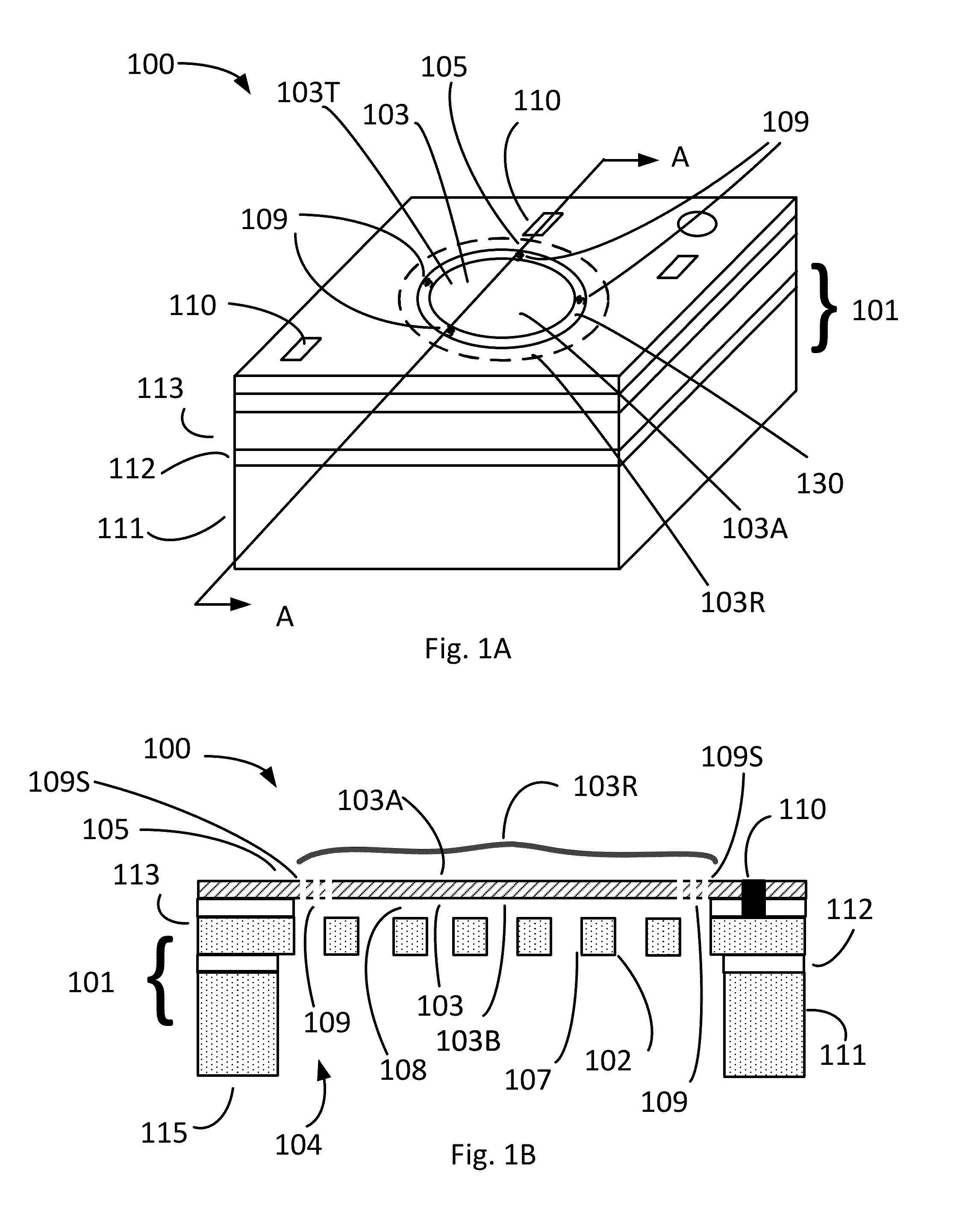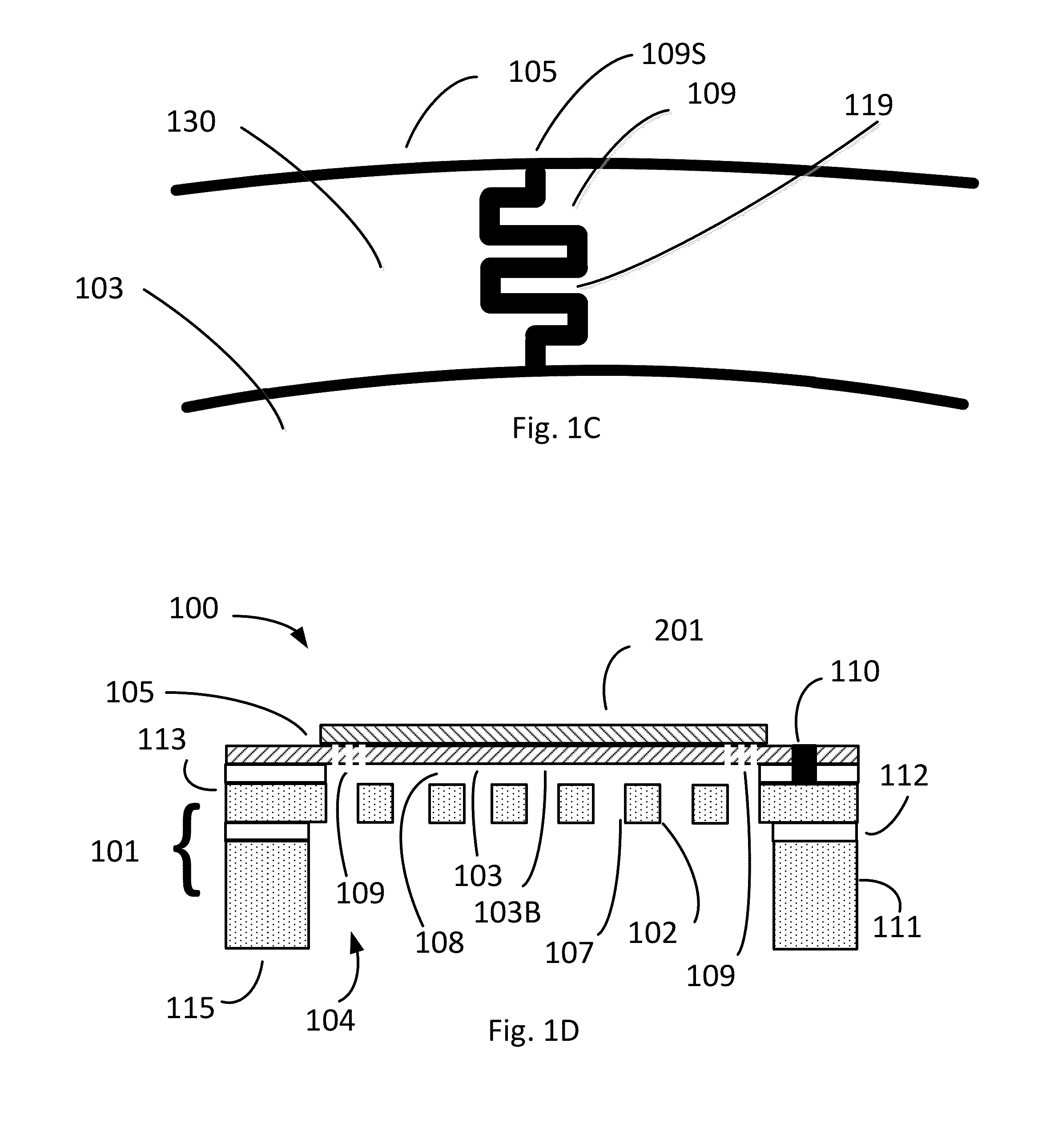Low Frequency Response Microphone Diaphragm Structures And Methods For Producing The Same
a diaphragm and microphone technology, applied in the field of microphones, can solve the problems of reducing the sensitivity of the microphone, limited low frequency response of the microphone, and the ability of the microphone's fabrication process to make very small slots
- Summary
- Abstract
- Description
- Claims
- Application Information
AI Technical Summary
Benefits of technology
Problems solved by technology
Method used
Image
Examples
first embodiment
[0006]In a first embodiment, a MEMS microphone includes a substrate having a plurality of diaphragm suspension points; a backplate; a diaphragm having a top side and an opposing bottom side, the diaphragm defining a diaphragm plane, the diaphragm separated from the plurality of diaphragm suspension points by a spring gap in the diaphragm plane; a plurality of springs within the diaphragm plane and within the spring gap, each of the plurality of springs coupled to the diaphragm and to a corresponding one of the plurality of diaphragm suspension points, such that the diaphragm is movably suspended from the plurality of diaphragm suspension points when the microphone is in operation, and such that the diaphragm is spaced from the backplate by a variable diaphragm gap; and a sealing layer laminated on the diaphragm and spanning the spring gap, wherein the backplate and diaphragm form a variable capacitor of a microphone.
[0007]Some embodiments have an equalization aperture to allow equal...
embodiment 200
[0047]In the embodiment 200 of FIG. 2A, the sealing layer 201 includes a sealing layer aperture 210 and the diaphragm 103 includes a diaphragm aperture 211 aligned with the sealing layer aperture 210. As used herein, the sealing layer aperture 210 and the diaphragm aperture 211 are aligned to form an equalization aperture 213, such that air can pass completely through the diaphragm 103 by passing through the sealing layer aperture 210 and the diaphragm aperture 211. In other words, the aperture 210 and the diaphragm aperture 211 are in fluid communication with each other. As such, the sealing layer aperture 210 and the diaphragm aperture 211 form a small equalization aperture 213 by which air pressure on the opposing faces of the diaphragm (top diaphragm face 103T and bottom diaphragm face 103B) can equalize.
[0048]Although the microphone 200 includes an equalization aperture 213, other embodiments (e.g., microphone 100 in FIG. 1B) may not have such equalization apertures. For exampl...
embodiment 230
[0052]In addition, the equalization aperture 213 may be located in a variety of locations. Indeed, in the embodiment 230 of FIG. 2B, the equalization aperture 213 passes through the sealing layer at the spring gap, so that air may pass through the equalization aperture 213 in the sealing layer and through the spring gap, without passing through an aperture in the diaphragm.
[0053]Another embodiment of a MEMS microphone 250 is schematically illustrated in FIG. 2C, in which the diaphragm 103 is suspended from diaphragm suspension points 109S by springs 109, and the backplate 102 is supported above the substrate 251. In microphone 250, the equalization aperture 213 is in the diaphragm, similar to the equalization aperture in microphone 200 in FIG. 2A. The substrate 251 may be a silicon-on-insulator wafer, or may by a different substrate on which various layers are disposed in the construction of the microphone 250.
[0054]Another embodiment of a MEMS microphone 270 is schematically illust...
PUM
| Property | Measurement | Unit |
|---|---|---|
| thickness | aaaaa | aaaaa |
| width | aaaaa | aaaaa |
| radius | aaaaa | aaaaa |
Abstract
Description
Claims
Application Information
 Login to View More
Login to View More - R&D
- Intellectual Property
- Life Sciences
- Materials
- Tech Scout
- Unparalleled Data Quality
- Higher Quality Content
- 60% Fewer Hallucinations
Browse by: Latest US Patents, China's latest patents, Technical Efficacy Thesaurus, Application Domain, Technology Topic, Popular Technical Reports.
© 2025 PatSnap. All rights reserved.Legal|Privacy policy|Modern Slavery Act Transparency Statement|Sitemap|About US| Contact US: help@patsnap.com



